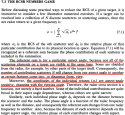Brumby
Major
I was surprised of your usage of "apologetics" as it is not a commonly known word even among English speakers .Apologetics describe a positive argument in favor of something,
And what kind of data is that supposed to be?? Didn't they already take the whole 3D model of the delta wing planes into simulation? Again, all the RCS calculation are obtained through computer, which should have automatically take into account all geometric changes of the wings during the simulation, giving you the final RCS result presented in that final graphs that you see on page 5. It's illogical to think there's more 'missing data' that you're still looking for; it's already aggregated in there.
I guess you tells us whether there is exclusion because the abstract of the document and the research seems to suggest a narrow focus of the study and analysis.
The abstract emphasized canard rotation and research component size stealth testing. This suggest to me a focus on the RCS of canards rather than the complete airframe

The following picture from the document supports such an idea. For sake of simplicity I am even discounting farfield requirements.

This is further supported from the document (translated) on the research premise that other stealth elements remain unchanged with focus being on component stealth testing i.e. canards.

In reality significant changes were made between pre and post canard incorporation to the wings (location) and on the tail surfaces.

These are the cascading effects that I was referring to especially when such changes would have an effect on its overall RCS beyond the readings on the canards. I have nor seen any 360 degrees all aspect RCS reading being presented such as the following.

The all aspect reading is not trivial as it is the primary requirement in RCS study as viewing angle is important..

source Radar Cross Section 2nd edition by Eugene Knott














